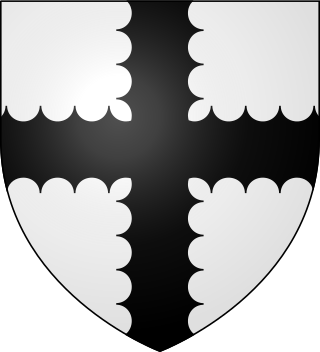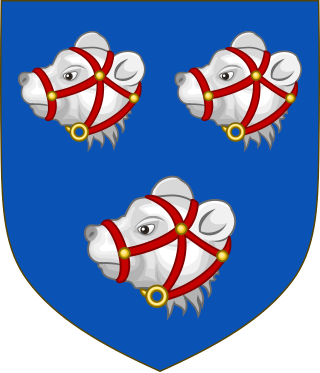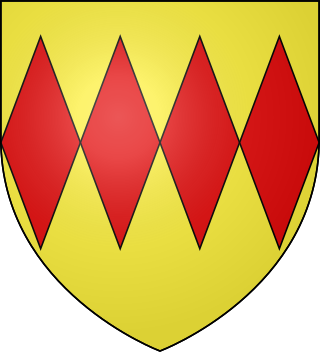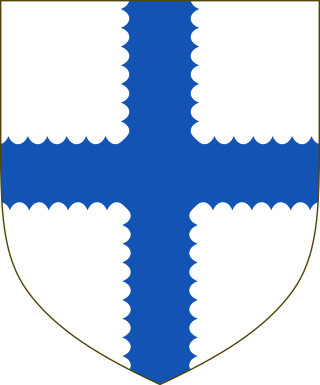Related Research Articles

William the Lion, sometimes styled William I and also known by the nickname Garbh, "the Rough", reigned as King of Scots from 1165 to 1214. His 48-year-long reign was the second longest in Scottish history, and the longest for a Scottish monarch before the Union of the Crowns in 1603.

William Douglas-Hamilton, Duke of Hamilton, KG, PC, also known as Lord William Douglas and the Earl of Selkirk, was a Scottish nobleman and politician. He was the eldest son of The 1st Marquess of Douglas by his second wife, Lady Mary Gordon, a daughter of The 1st Marquess of Huntly.

Henry I Sinclair, Earl of Orkney, Lord of Roslin was a Scottish and a Norwegian nobleman. Sinclair held the title Earl of Orkney and was Lord High Admiral of Scotland under the King of Scotland. He was sometimes identified by another spelling of his surname, St. Clair. He was the grandfather of William Sinclair, 1st Earl of Caithness, the builder of Rosslyn Chapel. He is best known today because of a modern legend that he took part in explorations of Greenland and North America almost 100 years before Christopher Columbus. William Thomson, in his book The New History of Orkney, wrote: "It has been Earl Henry's singular fate to enjoy an ever-expanding posthumous reputation which has very little to do with anything he achieved in his lifetime."
William Sinclair (1410–1480), 1st Earl of Caithness (1455–1476), last Earl (Jarl) of Orkney, 2nd Lord Sinclair and 11th Baron of Roslin was a Norwegian and Scottish nobleman and the builder of Rosslyn Chapel, in Midlothian.

Earl of Airlie is a title of the peerage in Scotland created on 2 April 1639 for James Ogilvy, 7th Lord Ogilvy of Airlie, along with the title “Lord Ogilvy of Alith and Lintrathen.” The title “Lord Ogilvy of Airlie” was then created on 28 April 1491.

Earl of Carrick is the title applied to the ruler of Carrick, subsequently part of the Peerage of Scotland. The position came to be strongly associated with the Scottish crown when Robert the Bruce, who had inherited it from his maternal kin, became King of the Scots in the early 14th century. Since the 15th century, the title of Earl of Carrick has automatically been held by the heir apparent to the throne, thus the current holder of the title is Prince William, Duke of Rothesay.
David of Scotland was a Scottish prince and 8th Earl of Huntingdon. He was, until 1198, heir to the Scottish throne.
When the crown of Scotland became vacant in September 1290 on the death of the seven-year-old Queen Margaret, 13 claimants to the throne came forward. Those with the most credible claims were John Balliol, Robert de Brus, 5th Lord of Annandale, John Hastings and Floris V, Count of Holland.
Patrick IV, 8th Earl of Dunbar and Earl of March, sometimes called Patrick de Dunbar "8th" Earl of March, was the most important magnate in the border regions of Scotland. He was one of the Competitors for the Crown of Scotland.

Clan Hay is a Scottish clan of the Grampian region of Scotland that has played an important part in the history and politics of the country. Members of the clan are to be found in most parts of Scotland and in many other parts of the world. However, the North East of Scotland, i.e. Aberdeenshire (historic), Banffshire, Morayshire and Nairnshire Nairn (boundaries), is the heart of Hay country with other significant concentrations of Hays being found in Perthshire, especially around Perth, in the Scottish Borders, and in Shetland.

Clan Oliphant is a Highland Scottish clan.
William de Brus, 3rd Lord of Annandale, was the second but eldest surviving son of Robert de Brus, 2nd Lord of Annandale.
Sir Alexander Home of that Ilk, 1st Lord Home was in 1448 Sheriff Deputy for Berwickshire, and was made a Lord of Parliament on 2 August 1473. He is an ancestor of the Earls of Home.
William Douglas, 1st Marquess of Douglas and 11th Earl of Angus (1589–1660) was a Scottish nobleman.
William II de Haya, was a Norman knight who is considered to be the progenitor of the Scottish Clan Hay. He is the first recorded de Haya in Scotland and is known to have been in the Scottish court in 1160.

Clan Forbes is a Highland Scottish clan from Aberdeenshire, Scotland.

Sir Robert de Pinkeney, Baron Pinkeney was a 13th-century English noble. He was a competitor for the Crown of Scotland and died in 1296.
James Balfour, 1st Baron Balfour of Glenawley or Clonawley was a Scottish nobleman and courtier who was one of the chief undertakers in the Plantation of Ulster. His third marriage to Anne Blayney caused a notable scandal.

William Sinclair was a Scottish nobleman and the 3rd Lord Sinclair. In The Scots Peerage by James Balfour Paul he is designated as the 2nd Lord Sinclair, but historian Roland Saint-Clair designates him the 3rd Lord Sinclair in reference to his descent from his grandfather, Henry II Sinclair, Earl of Orkney, the first Lord Sinclair. Roland Saint-Clair references this to an Act of the Scottish Parliament in which William Sinclair's son, Henry Sinclair, 4th Lord Sinclair, was made Lord Sinclair based on his descent from his great-grandfather, Henry II Sinclair, Earl of Orkney, the first Lord Sinclair. Bernard Burke, in his a Genealogical and Heraldic Dictionary of the Peerage and Baronetage of the British Empire, agrees with Roland Saint-Clair and says that Henry Sinclair was "in reality" the fourth holder of the title of Lord Sinclair.
Sir Claud Hamilton of Shawfield, PC (Ire), also called of Leckprevick, a younger son of Claud Hamilton, 1st Lord Paisley in Scotland, was a gentleman of the privy chamber of King James VI and I, an undertaker in the Plantation of Ulster, and a privy counsellor in Ireland.
References
- Balfour Paul, Vol. I